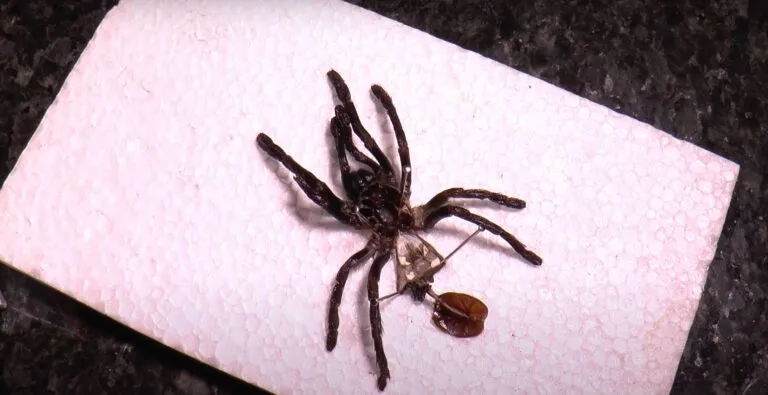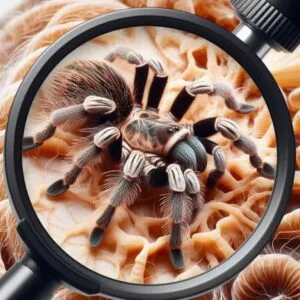Tarantula Gender Reveal Top 5 Tips
Determining the gender of your tarantula is a fascinating aspect of tarantula keeping, offering insights into their behavior, lifespan, and potential for breeding. Accurate sexing is essential for responsible care and successful breeding programs. This guide provides five essential tips to help you accurately identify your tarantula’s gender, ensuring you can provide the best possible care for your eight-legged friend. From examining molts to studying pedipalps, we’ll explore practical methods to reveal the secrets of your tarantula’s gender, empowering you with the knowledge to become a more informed and confident tarantula keeper. Understanding the male-female ratio can greatly influence your tarantula-keeping experience, whether for simple pet ownership or for breeding purposes. These tips will allow you to understand the intricate details to help you correctly identify your tarantula’s gender.
Understanding Tarantula Sexing Basics
Before diving into specific techniques, it’s crucial to grasp the fundamental reasons why sexing your tarantula matters. Accurate sex determination impacts various aspects of tarantula care and management. Sexing your tarantula allows you to understand its potential lifespan, which differs significantly between males and females. Female tarantulas generally live much longer, often exceeding 20 years, while males typically live only a few years after reaching maturity. Sexing helps with the breeding process if you plan to breed. Sexing determines whether you have the right pairing to successfully reproduce the species. Sexing also allows you to better anticipate certain behavioral traits. It allows you to understand whether it has the potential for defensive behaviors or its temperament.
Why Sexing Matters in Tarantula Care

The ability to sex a tarantula is important for several reasons. For beginners it is a great way to learn more about their pet. Advanced keepers might want to consider breeding tarantulas for profit or conservation. Having knowledge on your tarantula’s gender enables you to prepare for the different stages of life that are unique to male and female tarantulas. For example, knowing your tarantula’s gender is important because male tarantulas tend to have a shorter lifespan compared to females. Knowing your tarantula’s gender may also impact the care and living environment you provide. Females do well in secure enclosures that they can call home, while males tend to wander and are not that particular about their environment. Furthermore, sexing your tarantula enables you to better anticipate certain behavioral traits. Sexing helps you prepare for the different stages of life that are unique to male and female tarantulas.
The Significance of Male to Female Ratio
The male-to-female ratio significantly impacts several aspects of tarantula keeping. In breeding programs, this ratio is important because it influences the likelihood of successful reproduction. A good ratio can maximize the chances of successful matings and offspring production. The male-to-female ratio can also influence the overall dynamics of a tarantula collection. In collections, maintaining a balanced ratio can reduce competition. A balanced ratio minimizes the potential for aggression and fighting. In research and conservation, understanding and monitoring the male-to-female ratio helps track populations, assess their health, and make informed decisions about management and conservation efforts.
Tip 1 Identifying the Molt
One of the most reliable methods for sexing tarantulas is examining their molts. After molting, a tarantula sheds its exoskeleton, providing a clear view of its reproductive structures. This technique is most effective for sub-adult or adult tarantulas. The molt allows you to identify the sex without the need to handle the spider directly. This is very helpful in minimizing stress. This method is also useful because it can be done without disturbing your tarantula’s natural environment. Finding a recent molt is crucial, as the details needed for sexing are only visible on a fresh molt. The molt will clearly show the reproductive structures, allowing for a reliable gender identification, especially in mature specimens.
What to Look for in the Exoskeleton

When examining the exoskeleton, you’re looking for specific features that differ between males and females. These differences are typically found on the underside (ventral side) of the abdomen. Carefully examine the area between the book lungs, where the spermatheca of females is located. In a female, you should see a pair of spermathecae, which appear as distinct structures. These structures are where the female stores sperm after mating. This will look like a pouch or plate-like structure on the molt. On the other hand, male tarantulas will not have these structures. This is a key indicator of its gender. Ensure you have good lighting and a magnifying glass. This will allow you to inspect the fine details of the molt.
Examining the Spermatheca in Females
The spermathecae are the most obvious signs of a female tarantula. They appear as a pair of receptacles located on the ventral side of the abdomen. These structures are the sperm storage organs. Their presence clearly indicates a female tarantula. The shape and size of the spermathecae can vary slightly depending on the tarantula species, but they are generally visible as distinct structures. When inspecting the molt, use a magnifying glass and good lighting. This will help you to observe the details. Ensure the molt is clean and undamaged, as any tears or damage can obscure these crucial features. Identifying the spermathecae on the molt is one of the most reliable methods for confirming the gender of your tarantula. This allows keepers to accurately identify the gender with relative certainty.
Tip 2 Using a Magnifying Glass
Using a magnifying glass is an indispensable tool for tarantula sexing, especially when examining molts or directly observing the spider. A magnifying glass greatly enhances your ability to see the subtle differences. It makes the examination of the molt significantly easier. It helps you to identify the presence of spermathecae or the structures on the pedipalps. A good magnifying glass allows for closer inspection without stressing the tarantula, providing a detailed view. This tool is also helpful when observing the book lungs on a live tarantula. The choice of magnification level depends on the size of the tarantula and the specific features being examined. It is essential to choose a magnifying glass with good quality lenses to achieve a clear and accurate view. This tool will enhance your ability to determine the gender of your tarantula.
How to Properly Handle the Molt

Handling a tarantula molt requires a delicate touch and proper technique to avoid damage. The molt is fragile. It can tear or break easily if handled improperly. To start, gently remove the molt from the enclosure using tweezers or a small tool. Avoid tugging or pulling on it. Handle the molt in a well-lit area, free from drafts, to ensure optimal visibility. Lay the molt flat on a clean, non-reflective surface. The optimal surface is one that contrasts with the molt for better visibility. To examine, use a magnifying glass to observe the key sexing features. Be patient and take your time. Ensure that you don’t handle the molt for prolonged periods. This will decrease the chance of damaging it.
Detailed Examination Techniques
When examining the molt, start by inspecting the ventral side of the abdomen. This is where the key sexing features are located. Look for the presence of spermathecae in females. Look for the presence of palpal bulbs in males. Use a bright light and a magnifying glass to enhance the visibility of the details. If possible, compare the molt to reference images of known male and female tarantula molts for that species. This comparison can help in distinguishing subtle differences. Be patient and take your time. Proper and detailed examination is the key to correct sexing. This process may take a few attempts, but the end result is a far more confident and accurate determination.
Tip 3 Ventral Sexing Method
The ventral sexing method is a direct approach that involves inspecting the underside of the tarantula’s abdomen. This method is often used in conjunction with other sexing techniques, especially when a molt is unavailable. It requires a careful look at the area between the book lungs. This method involves observing live tarantulas. The method offers an immediate determination without the need to wait for a molt. The success of this method is dependent on the clarity of vision and the tarantula’s cooperation. To perform this method, you will need a clear view of the underside of the abdomen. A bright light source and a magnifying glass are essential for a clear view. This method provides valuable insight into the tarantula’s gender.
How to Identify the Book Lungs

Book lungs are respiratory organs located on the ventral side of the tarantula’s abdomen. They appear as a pair of slit-like openings. In males and females, the book lungs have similar appearances, but the area between the book lungs is where the differences appear. In the ventral sexing method, you examine this area. The book lungs will be visible between the spinnerets, but the sexing is performed by looking at the other structures. Examining the ventral side is helpful to get the correct determination. This involves a careful examination of the underside of the abdomen, between the book lungs.
Difference Between Male and Female Book Lungs
The primary difference between male and female tarantulas is the presence of reproductive structures, not the book lungs themselves. The book lungs are essentially the same. The structures that differentiate them are the spermathecae in females, located between the book lungs, and the absence of these structures in males. This distinction is readily observable when examining a molt. When sexing a live tarantula using the ventral method, you’re looking for the presence or absence of these reproductive organs, as the book lungs themselves do not provide the key indicators. You should inspect the underside of the abdomen. The area between the book lungs is where the key differences can be observed.
Tip 4 Comparing Pedipalps
The pedipalps are the small appendages located near the tarantula’s mouth, and their appearance differs greatly between males and females. This method is only useful in adult tarantulas. A male tarantula typically has modified pedipalps with palpal bulbs, which are used for mating. These bulbs appear as small, bulbous structures at the tips of the pedipalps. In contrast, female tarantulas have pedipalps that are similar in appearance to their other legs. The lack of palpal bulbs is a key characteristic of females. This method is easier when comparing to reference images. Comparing the pedipalps is a reliable method of sexing tarantulas. This method should only be used in mature tarantulas.
Examining the Pedipalps for Bulbs

Examining the pedipalps for bulbs is the primary way to determine a tarantula’s gender using this method. The palpal bulbs are the most distinctive feature of the male tarantula. They are located at the tips of the pedipalps. These are used to store and transfer sperm during mating. When inspecting the pedipalps, it’s crucial to have a clear view. This is best done with a well-lit area and a magnifying glass. The presence of the bulbs indicates a male tarantula. The absence of bulbs suggests a female. Take your time when examining the pedipalps. Compare them to visual guides. Look for the small, bulbous structures at the tips. The absence of palpal bulbs confirms the tarantula is female.
Identifying the Palpal Bulbs
Identifying palpal bulbs can be a straightforward process with the right tools and knowledge. The palpal bulbs are typically located on the tips of the pedipalps. They are distinct structures that look like small, rounded bulbs. In many species, the bulbs are easily visible, especially in adult males. Use a bright light and a magnifying glass to enhance visibility. Study reference images of known male tarantulas for that specific species. This will help you understand what the palpal bulbs look like. The palpal bulbs confirm that the tarantula is male. The absence of the bulbs indicates the tarantula is a female.
Tip 5 Consulting with Experts
When you are uncertain about a tarantula’s gender, seek the help of experienced breeders, keepers, or experts in tarantula sexing. A second opinion is always helpful, especially for less experienced keepers. Experts often have extensive experience and can identify subtle differences. They will be able to identify details you might miss. Experts can provide an accurate assessment. They can also offer invaluable insights. This ensures that you’re confident in your sexing and your tarantula care plan. Expert consultation adds an additional layer of certainty. This is particularly important when it comes to breeding programs. These are the experts who can offer the most reliable advice.
When to Seek Professional Assistance

There are several scenarios in which seeking professional assistance is advisable. If you are new to tarantula keeping, and if you are having trouble sexing the tarantula, then you should seek an expert. If the tarantula’s molt is damaged or incomplete, it will be difficult to accurately identify the gender. If the tarantula is a rare or valuable species, it is best to get the opinion of an expert. If you plan on breeding, seek expert guidance to ensure correct sexing and breeding success. If you’re unsure, it’s always best to consult with an expert to ensure accuracy.
Finding Reputable Tarantula Breeders
When seeking expert assistance, it is important to find reputable tarantula breeders. These breeders are often the best source of reliable information. Look for breeders with established reputations. They should have a proven track record of successful breeding and ethical practices. Look for breeders who are actively involved in the tarantula community. Their activity shows that they are dedicated and knowledgeable. Look for breeders who are willing to share their expertise and provide clear guidance. Ensure that they are willing to answer your questions thoroughly. Check reviews and testimonials from other keepers. This will give you an idea of their reliability and expertise. Finding reputable breeders is crucial. It ensures you receive accurate advice and support for your tarantula-keeping journey.
